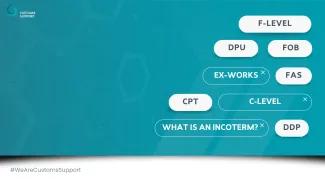What is an incoterm?
International commercial terms (incoterms) are a standardised set of trading rules published by the International Chamber of Commerce, which are designed to highlight the responsibilities and risks of the seller and buyer when trading goods. The latest set of incoterms was published in 2020.
There are four levels of terms that traders use, which gradually give more responsibility to the seller:
E-level incoterm EXW
There is only one E-level incoterm: Ex-Works (EXW). Under this incoterm, the seller only has to make the goods available for collection in a condition that is suitable for transit (packaged).
The buyer is responsible for everything else, including export customs clearance and loading the goods onto the collection vehicle. However, many sellers will load the vehicle on collection as they are in a better position to do so.
F-level incoterms FCA FAS FOB
Under the F-level incoterms, the seller is required to load the goods onto a vehicle or arrange the first part of the freight.
Free Carrier - FCA
The FCA incoterm is suitable for any mode of transport. Under FCA, there is a choice of delivery point, either at the seller’s premises or another named place such as a consolidation warehouse. The seller must load the goods on the seller's means of transport. This includes export customs clearance and loading the goods onto the vehicle.
Free Alongside Ship FAS and Free On Board FOB
Suitable only for water transport, the FAS and FOB incoterms require the seller to present the goods to a named port. The difference between the two terms lies in the transfer of risk.
For FAS shipments, the buyer assumes all risk once the goods are presented to the port terminal.
When the shipment is FOB, the risk doesn’t transfer until the goods are off the port and onto the vessel.
C-level incoterms C&F CIF CPT CIP
C-level incoterms place more responsibility for the freight onto the shipper. Which one is suitable for your goods depends on the mode of transport and the inclusion of insurance.
Cost and Freight C&F and Carriage Paid to CPT
The C&F and CPT terms are nearly identical, in that the cost and risk during transit (to a named destination) are the responsibility of the seller. Note that the transfer of risk to the buyer is much earlier during transport usually when the goods are handed over to the carrier at origin. The Seller is only obligated to pay for the transport to the destination but not ensure they arrive.
The difference is that C&F is only suitable for water transport and includes considerations around port risks, whereas CPT is for any mode of transport
Cost, Insurance, Freight CIF and Carriage and Insurance Paid to CIP
The CIF and CIP incoterms are the same as C&F and CPT, except the seller must provide insurance for the shipment until the place of destination.
Like with C&F and CPT, the mode is important for these terms. CIF is only for water transport, and CIP is for any mode of transport.
Due to the inclusion of insurance, there are levels of CIF and CIP which indicate the level of coverage.
D-level incoterms DPU DAP DDP
The D-level incoterms require the seller to contract all carriage in both countries, delivering the goods to the buyer’s named place.
Delivered at Place Unloaded DPU and Delivered At Place DAP
The DPU and DAP terms require the goods to be delivered to the buyer at a named place. The difference between them is that the buyer is required to unload the goods on the DAP term, whereas the seller is responsible for this on the DPU term.
Even if the buyer unloads the goods on the DPU incoterm, the seller bears the risk until the goods are unloaded. This is a common reason for dispute as goods do shift in transit, and damages can be incurred by this and/or improper handling by the unloading staff.
Delivered Duty Paid DDP
The Delivered Duty Paid DDP term builds on the DAP term, where the seller is responsible for everything until the goods are ready for unloading at the agreed place of arrival. In addition, the seller is also the importer of record and responsible for paying the import duty and VAT.
How incoterms can impact your customs processes
Although incoterms are mostly used to dictate risks and responsibilities from a logistics perspective, the term which you choose can carry risks or difficulties surrounding your customs functions.
For example:
- If you are selling EXW, then you are not responsible for the export. The buyer is responsible for the export formalities. This can mean difficulties for you as the buyer may state you are the exporter with incorrect clearance instructions, not receiving documentation, or being unable to prove that you were correct in selling goods with zero VAT.
- If you are buying EXW, then you are responsible for arranging customs clearance within the country of origin. As you are not established, you may struggle to find a customs broker who is willing to give you indirect representation.
- Similarly, if you are selling under the DDP incoterm then you are required to find a customs agent within the country of destination who is willing to provide indirect representation to you as the importer of record.
Which incoterms are recommended?
The “easiest” incoterms are those at F and C levels, as the transfer of risk and responsibility are clearly defined. However, the term that is best for your trade can only be determined by the type of goods you are moving and your supply chain as a whole.
If you’d like to know more about incoterms and customs, contact one of our team today.














